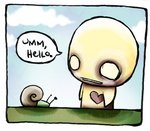Describe the three types of selection: directional, stabilizing and disruptive and give an example of each in your own words.
Natural selection can affect the distributions of phenotypes in any of three ways which are directional, stabilizing, and disruptive selection.
Directional selection helps those individual species that have extreme variations in traits within a population.
Stabilizing Selection are the average traits in a population.
Last of all, disruptive selection is similar to directional selection which helps the extremes traits in a population.
Stabilizing selection happens when individuals at one end of the curve have higher fitness than individuals in the middle or at the other end. For example, teenagers are the time of each life, most likely. Because teenagers are healthy, both emotional and physically for most of us, we can do so much that maybe adults and little kids cannot do.
 Therefore, most of us can eat whatever we want, learn a lot of different stuff from our public schools, we have so much privileges that some adults and kids don't have yet or have received already; we still have our upside-downs for teenages; for instance, when we cannot go to a horror movie because we are not old enough, or cannot drink red wine because we are still too young too, not that I want to presently. Kids can't just stay home alone without a parent because it is too dangerous, and their brains aren't fully developed whereas there are not much stuff/incidents for them to worry/think about. For adults, they have so much responsibilities because adults have to pay for their gas bills, take care of their children (if they have any), or even work hard on their jobs instead of slacking have which children can do right now in school if they choose to because their futures are not set yet. The middle is just right at the time of life.
Therefore, most of us can eat whatever we want, learn a lot of different stuff from our public schools, we have so much privileges that some adults and kids don't have yet or have received already; we still have our upside-downs for teenages; for instance, when we cannot go to a horror movie because we are not old enough, or cannot drink red wine because we are still too young too, not that I want to presently. Kids can't just stay home alone without a parent because it is too dangerous, and their brains aren't fully developed whereas there are not much stuff/incidents for them to worry/think about. For adults, they have so much responsibilities because adults have to pay for their gas bills, take care of their children (if they have any), or even work hard on their jobs instead of slacking have which children can do right now in school if they choose to because their futures are not set yet. The middle is just right at the time of life.
 Distriputive selection happens when individuals at the upper or lower ends of the curve have higher fitness than individuals near the middle, disruptive selection takes place which states the beginning or the ending is better than the middle. For example, you want to buy a pair of shoes but the worst part of buying those shoes you want is the middle because that is the part when you have to pay. In the beginning when you saw those pair of shoes, you just try it on and you look in the mirror and yourself if it looks pretty or feels comfortable for your feet. In the end, you buy the shoes and you can wear them right away and buying the shoes and having it in your hand are the results, which is one of the best times when purchasing a pair of shoes.
Distriputive selection happens when individuals at the upper or lower ends of the curve have higher fitness than individuals near the middle, disruptive selection takes place which states the beginning or the ending is better than the middle. For example, you want to buy a pair of shoes but the worst part of buying those shoes you want is the middle because that is the part when you have to pay. In the beginning when you saw those pair of shoes, you just try it on and you look in the mirror and yourself if it looks pretty or feels comfortable for your feet. In the end, you buy the shoes and you can wear them right away and buying the shoes and having it in your hand are the results, which is one of the best times when purchasing a pair of shoes.

Directional selection is a little different because it takes place when individuals near the center of a curve have higher fitness than individuals at either end. This can mean it's better to wear tennis shoes better than wearing flip flops when you are racing for the track team sport. Even though this example seems really obvious, it is a simple, yet good exampple for directional selection. This example demonstrates how wearing the best shoes improve on your running and also standing. Wearing tennis shoes instead of flip flop shoes can make your feet feel more comfortable inside and it won't get your foot injured as easily when you probaly stepped on a nail on the floor. Wearing flips flops may cause injuries like slipping easily or having an impact that may cause your feet to hurt if your sprint. It can also bring you to the first place trophy if you wear good shoes!

No comments:
Post a Comment